Hello there! If you’re new to the game, you’ve come to the right place. This article addresses the key cards and strategies for each faction to give you a sense of their play-styles, strengths, and weaknesses.
Cards from the Core set will be denoted as such. Any other cards come from chapter pack or deluxe expansions.
I recommend installing an app like Hover Zoom so you can place your cursor over each card link to see the image without leaving the page.
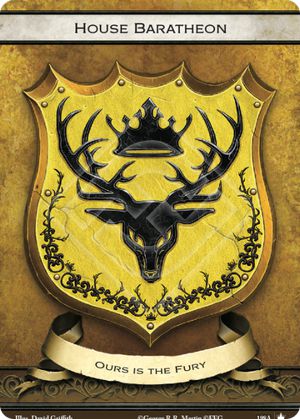
Strengths: Control through kneel (tapping/exhausting enemies), Power challenges, Winning dominance
Weaknesses: Reliant on key characters, countered by stand effects
The Stags hold the Iron Throne at the opening of A Song of Ice and Fire, and their play style is very consolidating and reactive as they attempt to hold on to this status. House Baratheon doesn’t focus so much on claiming power, as they did in the first edition; rather, they want to hold onto the power they have. In general, the Baratheons try to subdue, avoid, and appease threats, using kneeling tactics instead of killing or harming their subjects. At the heart of it, House Baratheon exists in a position of privilege and entitlement (which makes them good at winning dominance), and they want things to stay the way they are. There is a little bit of a reverse-landslide mentality guiding this faction – House Baratheon is trying to prevent everything they’ve gained from falling apart.
Robert Baratheon
(Core) is a monster in challenges because of his plus strength bonus and keywords. He grows stronger as surrounding characters kneel (thematically bending the knee -- it's good to be the King).
Stannis Baratheon
(Core) locks down a large board, allowing you to focus on appeasing fewer threats each round. Both Robert and Stannis are vulnerable to
Tears of Lys
(Core), but you can shore up that weakness with
Bodyguard
(Core),
Little Bird
(Core), or
Selyse Baratheon
(Core).
The Red Keep
(Core) and
Moon Boy
demonstrate the Baratheon’s commitment to power challenges (the blue crown icon). They need to win power challenges consistently, or at least not lose, in order to draw cards.
Melisandre
(Core) is a repeatable “engine”. Provided you can marshal or play a card with the R’hllor trait once per round, you then kneel any opposing threat (a kind of temporary “soft” control). Other noteworthy R’hllor cards include
Lightbringer
(Core), a weapon that’s fantastic on Robert or Stannis, and
Seen in Flames
(Core), a powerful hand control event. You want to find Melisandre quickly, usually through a plot like
Summons
(Core), and focus on keeping her alive -- beware of
Dracarys!
(Core) and
Put to the Sword
(Core). There are also a few non-R'hllor kneel cards, like
Even Handed Justice
and
Consolidation of Power
(Core).
The Baratheon’s also feature a dominance-winning module. They use cards like
Iron Throne
(Core) and
Fiery Followers
(Core) to have the highest standing strength plus remaining gold during the dominance phase, which will earn them one power towards the victory total. Then cards like
Gendry
,
Tobho Mott’s Armory
,
Chamber of the Painted Table
(Core) and
Feast for Crows
(Core) give you extra benefits for winning dominance.
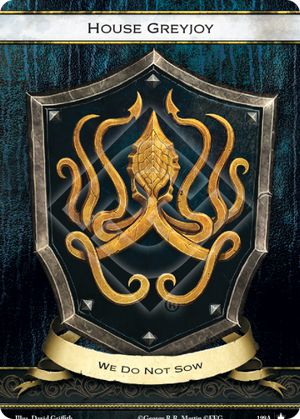
Strengths: Stealth & unopposed challenges, power rush, aggression
Weaknesses: Lack of intrigue icons, reliant on being first player, stymied by opponent's attachments
The Krakens are tactical and impulsive. They want to attack and exploit any weakness in their opponents and take advantage of temporary opportunities by gaining benefits from unopposed challenges. House Greyjoy is rash and quick to act, so they prefer to be the first player. They also play the tempo game well. In addition, the Greyjoys do not sow and they’re quick to raze the fields of their foes by destroying enemy locations. Finally, House Greyjoy is resilient and difficult to kill. After all, what is dead may never die…
The primary Greyjoy strategy focuses on winning “unopposed” challenges. They feature many “stealth” characters who can bypass defenders, such as
Asha Greyjoy
(Core) and
Theon Greyjoy
(Core). Their most potent threat is undoubtedly
Balon Greyjoy
(Core), who can only be blocked a characters with equal or higher strength. The Greyjoys also use other tricks, such as
Raiding Longship
,
Fishing Net
, and
Kraken’s Grasp
(Core) to neutralize defending characters. Then, after successfully winning a challenge without defenders, there are many powerful benefits such as targeted kill from
Seastone Chair
, card draw from
The Reader
, and power gain from
Great Kraken
(Core). Some of these tricks can’t affect opposing characters who wield attachments, so Greyjoys often run some form of attachment removal like
Weapons at the Door
.
The Greyjoys are the most location-dependent faction. They love warships like
Iron Fleet Scout
(Core) and other cards that benefit when you amass a large fleet like
Drowned Men
(Core). But beware of
Put to the Torch
(Core) and
Political Disaster
.
Speaking of location control, the Greyjoys themselves specialize in that area, with both “soft” control from
Lordsport Shipwright
(Core) and “hard” removal from
Newly Made Lord
and
We Do Not Sow
. On a tangentially-related note, Greyjoy's also like to Pillage (mill) opposing decks, and then take the spoils with cards like
Euron Crow's Eye
(Core).
Finally, the Greyjoys are hard to kill. “Save” effects like
Risen from the Sea
and Iron Mines help them escape death from military claim or card effects like Tears of Lys (Core) and Put to the Sword (Core). They also have
Aeron Damphair
(Core) to revive any Ironborn-traited character.
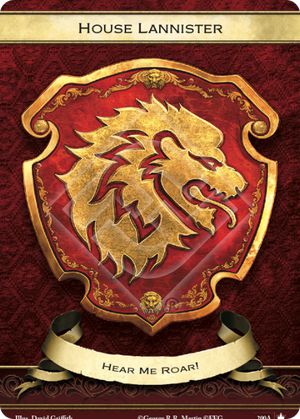
Strengths: Intrigue and Military challenges, extra economy, efficient characters
Weaknesses: Relatively reliant on variance, power challenges
The Lions are devious, manipulative, and indirect. They are ambush specialists, they play the intrigue game aggressively, and they are extremely wealthy. Figuratively, they are “monsters.” They’re not averse to using torture and intimidation to achieve their goals, and this faction is the home for a number of characters who can be quite frightening when they hit the board. There’s also a chaotic aspect to this faction – the Lannisters deal with a fair number of wild cards and unpredictable entities on their path to the Iron Throne, and being able to make the resultant chaos work in your favor is an important skill for leading this faction.
The Lannisters feature some of the game’s most efficient characters.
Tywin Lannister
(Core) and
Tyrion Lannister
(Core) give you extra spending money, allowing you to build decks without adhering to some of the normal economy guidelines. Marshaling them early can lead to a big advantage in the long run.
Ser Jaime Lannister
(Core) and
Ser Gregor Clegane
specialize in military challenges, so Lannister often runs
Put to the Sword
(Core) to capitalize.
Cersei Lannister
(Core) specializes in intrigue challenges, while
Casterly Rock
(Core) allows you to make multiple such challenges and
Lannisport
(Core) lets you draw a card for winning one. The Lannisters are relatively light on power icons, so Greyjoy and Baratheon decks are often able to capitalize on this weakness.
Finally, there’s an archetype known as “Leaping Lions” because the Lannisters feature many characters with the ambush keyword, such as
Burned Men
(Core) and
The Hound
. They also bring pseudo-ambush effects such as
Hear Me Roar!
(Core) that allow you to jump a character into play unexpectedly during the middle of the challenges phase. The Lannisters take advantage of this strength by using plots like
First Snow of Winter
that will give them a numerical advantage after extra character jump into the fray.

Strengths: Acting second, icon manipulation (soft control), the long game
Weaknesses: Acting first, relatively weaker characters, the early game
The Martells are patient and strategic, preferring to play the long game rather than making an immediate rush for victory. They often avoid being the first player, waiting to see what their opponents do before making their move. The Martells are also vengeful, always looking for the chance to mete out retribution for past wrongs. House Martell is also prone to sweeping, dramatic gestures: with the Martells, it’s not just about winning, it's about making a show of winning. The concept of the delayed rush – building up slowly and plotting behind the scenes to set up “one big turn” – is strongest with the Martells.
Cards like
Doran Martell
(Core),
Dawn
(Core) and
Doran’s Game
(Core) grow stronger or more effective in the later stages of the game. To survive that long, the Martell faction relies on “icon manipulation” to help them win key challenges. Cards like
Nymeria Sand
,
Maester Calleote
(Core),
Condemned
and
A Game of Thrones
(Core) limit the opponent’s options. The Martell faction is naturally weak to decks that can either win or establish a dominating board position early.
The Martells like to play second and react to an opponent’s attacks. Cards like
Quentyn Martell
,
Palace Spearman
(Core), and
Sunspear
(Core) demonstrate this tendency. The player who wins initiative during the Plot phase chooses which player will act first during the round, so a crafty Martell strategist will often run high initiative plots in order to control this decision.
Finally, the Martells are able to win even when they lose. Cards like
Ghaston Grey
(Core),
the Boneway
and
the Long Plan
activate after a challenge defeat, and make the opponent regret ever engaging you in battle.
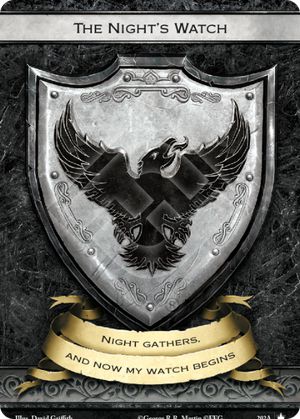
Strengths: Defensive tactics, passive power gain, strong locations and attachments
Weaknesses: Many mono-cons (characters with a single challenge icon, making them inflexible), Character control like stealth, kneel, and icon manipulation
The Night's Watch are the scavengers of the realm, and they’re adept at picking up scraps and using what others have thrown away or left behind. They are sworn to defend the Wall and because of this, they’re fierce when defending challenges. The Night’s Watch also has a specialized character base as they divide their tasks and strengths among Stewards, Rangers, and Builders. As a faction, playing the Night's Watch feels the most distinct from the others. After all, they’re not a Great House and they operate with a different set of goals.
Without question, the major Night’s Watch strategy is to find, marshal, and defend
The Wall
(Core). Once it’s in play, the Wall gives 2 power (out of 15 needed to win) every round, as long as you opposed every challenge thrown at you. To help accomplish this task, the Watch features characters that either have the Stealth keyword, like
Will
and
Ghost
, or are unaffected by it, like
Benjen Stark
(Core). They can also defend the Wall with a horde of cheap characters, like
Yoren
, but this makes them susceptible to
Wildfire Assault
.
They also use locations like
The Shadow Tower
and
Castle Black
(Core) to deter attacks and make “challenge math” difficult for opponents to figure. Furthermore, if you throw too little strength at the Watch, they can defend and activate
The Sword in the Darkness
(Core). But if you attack with too many forces, look out for
Watchers on the Walls
.
The Rangers of the Watch, such as
Ranging Party
, specialize in military challenges. The Stewards like
Samwell Tarly
always have intrigue icons. And the Builders like
Veteran Builder
round out the icon spread with the power icon. The Watch also have some flexibility outside this rigid structure in characters like
Unsworn Apprentice
, who can fill whatever role you need.
Finally, the economy and draw engines of the Watch are distinct in style from the Great House factions. For money, they have
Old Forest Hunter
and
Meager Contribution
(rather than a limited location like Lannister’s Western Fiefdom). For card advantage, they have
Messenger Raven
, a repeatable and easy to trigger engine – if you can pay to marshal him again each round.
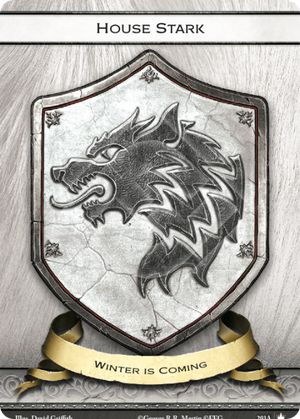
Strengths: Military challenges, self-sacrifice, standing
Weaknesses: Intrigue challenges, many cheap characters prone to weenie control
The Starks are honorable but unyielding, harsh in their judgement and direct in their punishment of those who offend. They have a pack mentality, they understand the notion of sacrifice for the greater good, and they can rally together when one of their own is in trouble. More often than not, they are military aggressors, taking the fight directly to their enemies. This faction is also the natural home of the "Ned" player type (who desires story immersion above all else), and House Stark will be the place where the explicit "nods to Ned" are most frequent.
After the release of the game’s first deluxe expansion, Wolves of the North, the Starks filled out their theme of sacrificing for the greater good.
Robb Stark
(Core) stands your entire team, and
Catelyn Stark
gains both power and strength when a Stark character leaves the arena.
Jon Snow
can initiate a sacrifice whenever needed, and
Jory Cassel
will give himself up to protect your major characters.
The Stark military expertise can be seen in efficient characters like
Arya Stark
(Core) and
Eddard Stark
. When the Starks win a military challenge, they often capitalize.
Rodrick Cassel
and
For the North!
(Core) will give you more cards to work with, while
Ice
(Core) and
Winter Is Coming
(Core) will punish opponents by killing their characters.
The Starks are often described as the game’s “police” because of their cards that disallow opposing card effects.
Catelyn Stark
(Core) and
Winterfell
pre-emptively stop shenanigans, while
Bran Stark
(Core) and
The Pack Survives
let you cancel unwanted surprises.
There’s a “tribal” Direwolf theme ingrained in many Stark cards.
Grey Wind
(Core) and
Wolves of the North
can munch on opposing characters.
Lady
and
Nymeria
are attachments that give bonuses to the Stark character that they accompany.
Like Warm Rain
(Core) helps to shore up the greatest Stark weakness, intrigue challenges.
A Time for Wolves
and
Wolf Dreams
let you tutor for the right Direwolf to suit your needs.
Finally, related to the Direwolve module is a "naval" package (a term that roughly corresponds to a first edition mechanic). Cards like
Winterfell Kennel Master
and
Wardens of the North allow
you to add characters to a challenge outside of the normal framework for declaring attackers and defenders, making it difficult for opponent's to anticipate your moves.

Strengths: Standing, Military challenges, targeted kills
Weaknesses: Reliant on key characters, Intrigue challenges
The Targaryens are in the position of attacking from outside of Westeros, and as such, they tend to focus on building up and snowballing potential, as well as rising from the ashes with standing effects. This faction relies on its leadership more than most other factions, rallying and coming together around strong leaders like Daenerys Targaryen and Khal Drogo. As the only House with access to dragons, burn (reducing STR and killing characters in this way) is still a central element of House Targaryen. Building your momentum and using that momentum to pressure your opponent are important parts of House Targaryen’s identity.
Strength-reducing “burn” effects that kill, such as
Blood of the Dragon
,
Dracarys!
(Core),
Crown of Gold
, and
Plaza of Punishment
(Core), give Targaryens potent board control. They will often combine multiple strength reductions together to eliminate even high-strength characters. Additionally, strength reductions like
Dragon Sight
and
Daenerys Targaryen
(Core) can help swing challenges in your favor, even if the affected characters aren’t diminished all the way to zero strength.
Speaking of Daenerys, she’s a central figure for the faction, as both the main draw engine (via her Insight keyword) and the beneficiary of her dragon’s abilities.
Rhaegal
(Core),
Viserion
(Core), and
Drogon
(Core) all buff Dany in some way, making Targ somewhat of a combo faction, but thanks to
Fire and Blood
the pieces are resilient.
The Targaryen’s feature “stand’ (untap) abilities that act as a direct counter to Baratheon kneel, as seen on
Magister Illyrio
,
Handmaiden
, and
Waking the Dragon
. This also gives them the flexibility to attack or defend with a powerful character like Daenerys multiple times in one challenge phase.
The “tribal” or trait-based theme in Targaryen revolves around aggressive Dothraki characters, like
Khal Drogo
(Core),
Aggo
and
Rakharo
. It’s not fully fleshed out yet, but you can see the potential.
Another minor theme involves the Targaryen relationship with attachments.
Vaes Dothrak
and
Viserys Targaryen
can remove them, while
Merchant Prince
loves acquiring them.
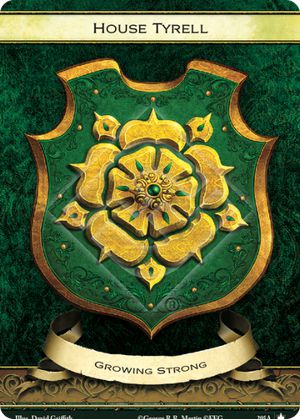
Strengths: Good icon spread, card draw and economy, strength increases
Weaknesses: Relatively weak high-cost "bomb" characters
The Tyrells are a "more than meets the eye" faction. On the surface, they seem pretty straightforward, but the Tyrells usually operate with a hidden scheme waiting in the wings. The servants and bannermen of House Tyrell are numerous and wealthy, making this faction second in resources only to the Lannisters. The Tyrells are the masters of manipulation in the game, and in some ways, they’re a combo faction with noticeable synergies between their faction’s cards. Finally, the words of House Tyrell are "Growing Strong" so, as you might imagine, raising strength is a significant part of Tyrell strategy.
Tyrell wealth is on display most prominently with
The Arbor
, which will provide massive long-run gains in return for an immediate tempo hit (four gold to marshal).
Paxter Redwyne
(Core) provides extra economy from both his gold bonus and reduction of event costs. And the
Queen of Thorns
(Core) lets you “jump in” a character for free when she wins an intrigue challenge -- a potentially huge advantage.
Randyll Tarly
(Core) is the poster boy for the Tyrell “strength raising” theme. Cards like
Growing Strong
(Core),
Margaery Tyrell
(Core), and
Heartsbane
(Core) help you win challenges you would have otherwise lost, or turn a small margin of victory into a blowout in order to trigger effects like
The Mander
(Core) and
Superior Claim
.
The Tyrell faction is home to some other forms of challenge trickery as well. Challenge control effects like
Highgarden
(Core) and
Mare in Heat
remove opposing characters so you more assuredly win the challenges you want to prioritize.
Finally, many Tyrell characters have the Knight trait or benefit Knights, such as
Knight of Flowers
(Core) and
Lady Sansa’s Rose
. There are also neutral cards such as
Hedge Knight
and
Tourney for the King
that help flesh out this theme. The Knights also support the Ladies of the faction, as evidenced by
Ser Hobber Redwyne
.
Conclusion
Thanks for reading!
Many players give their loyalty to a single faction, but others bounce around frequently, dabbling in everything. If you have any questions, feel free to ask here in the comments, or in the
Discord chat group
or
worldwide Facebook group
. Also check out the
Community FAQ
, a comprehensive list of resources for the game, like decklists, podcasts, articles, videos and more. I'll be back soon with a look at the Banner agendas and what each faction can lend to another.